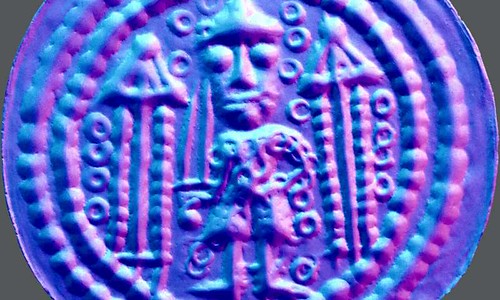
PREV ARTICLE
NEXT ARTICLE
FULL ISSUE
PREV FULL ISSUE
FACIAL RECOGNITION FOR COINSEd Hohertz passed along this encouraging article about a new method for identifying and classifying coins based only on digital scans. -Editor  OSCAR coin surface scan Countless historical coins that differ from each other only in details are in storage at German state museums. Unlike paintings, these archaeological artifacts may not be labeled, marked or barcoded. Researchers at the Fraunhofer Institute for Factory Operation and Automation IFF developed a scanner and analysis software in collaboration with the Saxony-Anhalt State Office for Heritage Management and Archaeology, which digitally capture the visual features of coins and describe them exactly in a matter of seconds. The scanning system can be used to identify and recognize coin finds. Fake or original? Even experts with a trained eye have difficulty answering this question in relation to historical coins. How, for instance, can forgeries returned to a museum instead of the coins loaned for an exhibition be recognized? How can switches and mix-ups be prevented among objects loaned by museums? Members of the staff at the Saxony-Anhalt State Office for Heritage Management and Archaeology were also seeking answers to these questions. Around 20,000 coins, often several centuries old, are stored in the State Office's archives and vaults. The collection is constantly growing. Until now, this unmanageably wide array of historical coins has been laboriously recorded and documented and by hand. Unlike paintings, the coins may not be labeled, marked or barcoded. In search of a solution to this problem and as part of the state of Saxony-Anhalt's digitization campaign that includes the digitization of cultural heritage, archaeological finds and historical coins, the State Office turned to the Fraunhofer IFF in Magdeburg.  OSCAR combined scan "The State Office aimed to digitize its complete numismatic collection. This gave rise to the idea of creating a digital fingerprint with which individual coins can be recognized and classified – much like facial recognition of people. The fingerprint replaces the bar-code as it were," says Dr. Christian Teutsch, research scientist at the Fraunhofer IFF, recounting the first contact with the State Office for Heritage Management and Archaeology. The closely collaborating partners designed a visual data acquisition system and software analysis system in their project "Digital Fingerprints of Archaeological Finds: Artifact Identification and Recognition Prototype", which does this by digitizing and exactly describing the old coins and obtaining unique signatures from the coins. The scanning system had to achieve a recognition rate of ninety-eight percent or more, operate contactless, and acquire the data of both faces. Gold, silver, bronze and copper coins with diameters of five to seventy-five millimeters were tested. The novel scanner O.S.C.A.R., short for Optical System for Coin Analysis and Recognition, not only scans coins' visual features but also the minutest signs of wear such as scratching, clipping, contours, edges, pitting and denting, which render an object unique. This is indispensable for being able to identify many coins of the same type. The scanner comprises several cameras and several light sources that illuminate coins from different directions, allowing high-precision resolution and magnification. This enables Teutsch and his team to highlight and scan every feature without any glare or reflection. "The light sources can be rotated on the monitor virtually and moved over a coin's surface as desired. That is a major benefit for numismatists, who will now be able to identify only poorly recognizable obverses and reverses much faster and more precisely," stresses Teutsch. The new scanning system makes it possible to digitize and document the numismatic collection automatically, expediting the laborious work tremendously. The project partners have already scanned in 10,000 coins. The complete collection of 20,000 specimens will soon be digitized. Numismatists were duly impressed after an initial presentation of the prototype. "The new scanning system will revolutionize numismatics in Europe," says Teutsch... Could technology finally have an answer to this age-old problem? Time will tell. But this is encouraging progress. It's a big data problem, for sure. Multiple cameras, lens, angles and sophisticated software algorithms are the cost of admission to this game. Many of the pieces have been too expensive or not even invented yet when earlier computer vision systems for coins have been attempted. We'll eagerly await further refinements and results. -Editor To read the complete article, see:  Wayne Homren, Editor The Numismatic Bibliomania Society is a non-profit organization promoting numismatic literature. See our web site at coinbooks.org. To submit items for publication in The E-Sylum, write to the Editor at this address: whomren@gmail.com To subscribe go to: https://my.binhost.com/lists/listinfo/esylum All Rights Reserved. NBS Home Page Contact the NBS webmaster 
|